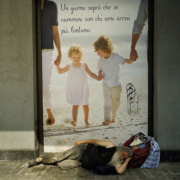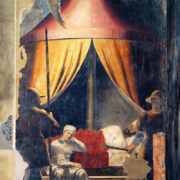The Love that moves the Sun and the other Stars (1) Short Presentation of the edition: “Although we are women” (2)
I would like to a give a special thank you to Silvia Cimino and Luca Cerniglia, for their editorial collaboration; and to Claudio Neri, who gave life to the first working group within the course “Female groups”
“I do not know us” were the first words spoken by Bion, after an intense silence at the seminar in Rome where he met members of the “Pollaiolo” (3). I do not know us (not: you).
I do not know us and do not know who we are – Bion might have said, when asked to speak only of the group of women? Not men, not men and women: only women.
Recalling that seminar I ask myself: why in this edition do we talk about only one “half of the sky” (4)?
All of us have always heard the discussions on the subject of the woman (but not of the man, because in that case we would be speaking about the human race).
She was forbidden and taboo in the anthropological community.
She was war at Troy in Greek mythology. Medea in the Greek theatre and in the mythological group: Bacchae. Erinyes. Parcae. Furies. Moirai. Eumenides. Grazie, Muse, nymphs, minor deities rich with mythological significance, derived from the major gods of Greek Olympus. Olympus was great and anthropomorphic, it was connected to intensely expressive myth-making ties and female representations (Artemis, Hera, Aphrodite, Athena, Demeter/Persephone), character personifying (Justice/Justitia, Dike, Victoria, Nike, Memoria, Concordia, Echo/Ekho), linked to natural life cycles (Selene, Aurora; Gaia) animal and semi-human figures (Chimera, Phoenix, Sphinx) the monstrous (Gorgona; Arpie) The evening star of the sky (Vespero) of the night (Venere) and of the dawn (Lucifero).
In the eastern culture she was represented as a many-breasted goddess with infinite powers.
Then, the rib of Adam, she was expelled from Eden and later became Announciata and Madonna.
She was the bearer of temptation and sin. Angelicata. Ascetic. Feudal ius primae noctis; banished to a convent. Witch. Saint. Heroine. Matriarch.
She was psychiatrically seen as disorder, imbalanced and criminal.
In the century of psychoanalysis, divided, in sexual development and self-identification between maternal dependence and the choice of a male object, embodied in biological needs and bodily needs, she was envious of the penis and struggling with feelings of rivalry and castration. Fragility, thy name is female (5).
Then feminist. Career Woman. Diva.
Stoned for being considered treacherous. Hidden by the burkha. Killed newborn before becoming an economic weight. Violated; owned; killed in honour killings and jealousy.
Fairy and Witch: ‘mobile qual piuma al vento’ (Mobile feather in the wind) (6). Yesterday social and prone to weaving relationships, today possessive, rivalling within the group dominated by the male and his power.
The women try to produce a camp in which they can find acknowledgement and confirmation: tradition has it that the vicissitudes constantly overwhelm the camp and that the interference and dispersion of identity is not able to confirm the existence and security of the camp.
The binding of the female camp (vitality and deep solidarity within the generative camp) renews its her sense of belonging and cohesion.
The notion of the camp, as group psychoanalysts have conceptualized and treated extensively, corresponds to the shared state of mind produced by subjects that are part of a group, which in turn contains the group and its participants. It may have different qualities and can be described by different perspectives (7); one of its constant characteristics is to promote the bonds of mirroring, resonance (8) and develop identifying processes but also separate and individual movements: in fact, the camp develops in the group a contro-campo (9) that contains also the desires to individualisation and distinction.
I think in particular about the possibility of a women’s camp capable of deep mirroring the metaphor comes from the myth of the goddess Baubo, dear to the feminist movement, which it effectively illustrates. Demeter robbed of his daughter Persephone that Hades, with the consent of Zeus had abducted and plunged into the underworld, cannot find rest and after having avenged himself by banning the fertility of the fields and having wandered among the gods and humans, is at the end distracted from his mourning by the goddess Baubo, who appears showing her genitals (in other versions, the goddess dances, whirling or wiggling her nipples, or whispering secret obscenities and speaking through the vagina, or is the nurturer of Demeter who raises her dress and shows the vulva).
The women’s camp like this would be a unifying and mirroring state that keeps an umbilical link with the female wellspring represented by Baubo. Baubo, linked to the Neolithic goddess of fertility, Greek goddess of obscenity, is without a head, and her face has a vagina for a mouth, which is placed on her legs and her eyes are nipples. She awakens in Demeter a smile and melts his grief and depression in laughter by connecting to a live and eternal element of the feminine camp, the aspect of obscenity tied to the sacredness of sexuality and fertility. Speaking from her vagina, she speaks as the author Clarissa Pinkola Estés has written in the book Women Who Run with Wolves “of the most important matter, the most fundamental level of sincere truth – the life-os” … And using the nipples as “psychic organs .. (that) react to heat, fear, anger, noise .. (In that they are) an organ of the senses as much as ones eyes. ”
Continuing the study maybe we could also speak about a male camp? Maybe about the communication and conjugation of the camps for women and men in the group (that is of the elaborate transformative encounters between the oedipal levels)? I remember that special time of group supervision with Francesco Corrao at The Pollaiolo, where the two of us brought the clinical sequences of two groups which had just begun, for discussion: one an all-male group led by a doctor, the other an all-female group led by me. I remember that, after the supervision group had been puzzled by the fact that the two groups by chance were one all-male and one all-female a particularly useful and sensitive debate developed.
So, therefore, I do not know who we are, I do not know us, but I can tolerate to meet us: the generative object that governs the universe, that tears apart and regenerating it, elevates it and lowers it, confuses it and makes it rise.
<<It’s useless, Winnicott wrote, to try to prevent wars and road fires, the expeditions up Everest or to Mars, or to abolish boxing, unless we examine what men want.
The women – all women by virtue of their identification with women of the past, of the present and of the future – face the risks of giving birth …. that is to say it is a danger inherent in the natural function of a woman. Men envy women that risk; they also feel guilty because they cause the pregnancy, and then sit and watch the women who face not only pregnancy, but also the birth, and the responsibility of the early care of the child that places major limitations on the woman. Like this, they too run risks, and always will. They try to emulate the woman. But when a man dies, he’s dead, while women have always existed and will exist forever. A man is like grass. So, also men also have their problems…. So, without wars, they feel empty, yet hate to be killed…. >>. (translated from the Italian version) Like this Winnicott wrote in his << ..digressions .. among the topics enclosed in the word ‘feminism’ that belong to the universal interaction between men and women. >> (10).
So in the womb of life, all events can take place, even the dismay and shock at life and the sight of the other living.
The third millennium, full of υβρισ that regulates every event – the Economic Society, Science, Nature, cannot cope however with the forces that move the universe, which generate the blood-lines that create pleasure to men and gods, that guides the sailors under the passing stars in the sky and which celebrates the harvests of the earth and mates the living: Venus (11), divine Venus, Love. The Love of which Freud, father, son, husband, lover and psychoanalyst, spoke. Or fifty years later with Bion: Love Hate Knowledge becoming the “O”, the ultimate Truth (12).
In this significant and creative edition many themes relative to the cycle of women’s lives are addressed, along with various specific and historical conditions, because “Although we are women, Fear we do not have / We have good tongues/ And we defend well! >> and especially because “the group (also the editorial one, A.n) could have its own specific function of an emerging object of a lunar nature, binding to the body and its humours: <<irreducible to the subject knowledge>> (Ferrari, 1994) in fact female thoughts are never really considered and integrated in the collective social events ” (Contributed by Simonetta Bruni to this Presentation).
Three authors, Giovanna Cantarella, Chiara Valentini and Ivana Arena, report the topics covered in their respective books recently published and reviewed in the Site (www.Funzione Gamma.it – Site) on the occasion of this edition.
The edition begins with a short and intense article by Chiara Valentini about the feminist movement. Followed by: a research on the gender and its role on therapeutic efficacy (Edith Lecourt et Aude Clémence Truquin). The catastrophic psychic trauma (Carole Bebe Tarantelli). Women in group therapy (Giovanna Cantarella). Agrophobia (Roberta D’Auria). The trauma and repair of neoplastic breast disease (Simonetta Bruni).
The theme of violence against women (Oria Gargano) that the recent International Day of the 26th of November showed in all its gravity (Eugenia Romanelli), is treated in various fields: the intimacy of the couple (Francesca Esposito); trafficking (Luca Cerniglia, Serena Bernabè, Marinella Paciello); prostitution (Germana Cesarano).
And again: childbirth (Ivana Arena). Depression after childbirth (Silvia Cimino). Pregnancy in women with diabetes (Silvia Mazzuca, Giorgia Morgese, Paolo Gentili, Natalia Visalli). The teachers in the school by Sabrina Di Cioccio (see in the Site the format in progress of the “Interviews”, directed by the author). The processing of trauma in the group (Roberta Richetta e Giuliana Ziliotto).
The rebellion through female images and imaginative dreams (Alessandra Scarpino).
And so then lets read, think and discuss on a telematic agora: we are women, with the right to live.
Or in the words of Silvia Corbella: “We are women, happy to be so, joyfully knowledgeable lovers of life” (13).
Notes
1) Dante, The Divine Comedy, Paradise XXXlll, 145.
2) The well known working ‘feminist’ song of political tradition that accompanied the first social struggle after the unification of Italy plays the refrain: <<Although we are women/ Fear we do not have/We have good tongues/And we defend well».
3) When in 1979, Wilfred R. Bion was invited to hold a meeting in Rome at the “Pollaiolo” with analysts, traders, and students of the Research Centre Group to meet the <<father>> of the formative ideas that inspired the Centre, he began, after a moment of silence, to issue the first sounds of his voice with these words: “I do not know us” (not: you… authors note NdA). This was enough to bring the group together in a single moment of experience and astonishment, the turbulence of the encounter, the fear of the unknown, the emotional state of dreaming, dreamlike.
4) Note the metaphor created to poetically define the woman by Mao Tse Tung, taken from the Red Book.
5) Shakespeare, Hamlet with references to Ophelia.
6) From the famous monologue of the Duke of Mantua in Rigoletto by Giuseppe Verdi.
7) The concept of the camp is treated extensively by Neri in Group (1998), Jessica Kingsey Publishers) in the Introduction and in cap.VI.
8) The group as an object-self is described in Group (2001, Routledge) by Neri, chapter XVI.
9) The concept is presented in the chapter devoted to the function of homogeneity in group analysis: S. Marinelli (2004), Gruppi omogenei, (Homogeneous groups), by R.Girelli, S.Corbella, S.Marinelli. Roma: Borla.
10) The quotation is taken from chapter The Thought and the Unconscious, Search for danger, pag.204, in The place of origin, published posthumously in 1986 and translated in Italy by Raffaello Cortina in 1990, Il luogo delle origini.
11) Free translation of the first verses of the preface of Lucretius’ De rerum natura.
12) The subject, treated in several works by Bion, is regularly defined in: Elements of Psychoanalysis, 1963. Tr.it Gli elementi della psicoanalisi. Armando1973, Rome.
13) Personal communication during an exchange on this issue.
Translated from Italian by Laura Rodriguez




